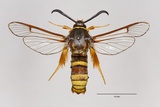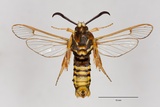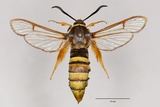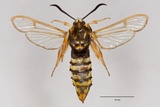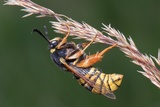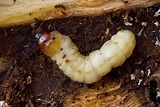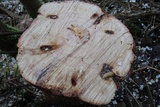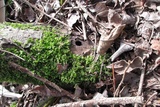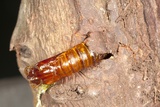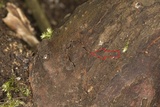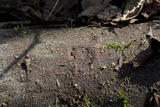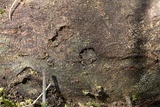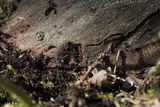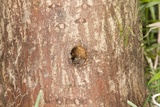Sesia bembeciformis (Hübner, [1806]) Species
Last modified: Nov. 21, 2025, 6:16 p.m.
This is a local species mainly observed in the northern part of Belgium. It can be abundant in suitable biotopes.
This species is considered Least Concern according to the IUCN Red List category for Flanders 2023.
Details
- Classification
- Family: Sesiidae > Subfamily: Sesiinae > Tribus: Sesiini > Genus: Sesia > Species: Sesia bembeciformis
- Vernacular names
- Gekraagde wespvlinder (NL), Lunar Hornet Moth (EN), Sésie du Saule (FR), Großer Weiden-Glasflügler (DE)
- Synonyms
- Sesia crabroniformis (Lewin, 1797), nec (Denis & Schiffermüller, 1775)
- First mention in Belgium
- Hübner J. 1796–1841. Sammlung europäischer Schmetterlinge. Vol. 2 Sphinges. — — 2: 1–194, pls 1–38. On page 92; pl. 20, fig. 98 (as Sphinx Bembeciformis). view page
- Status
-
Native
Distribution
Imago
S. bembeciformis is one of the largest clearwing species in Belgium (30–50 mm) making it, on average, only slightly smaller than S. apiformis, its closest congener. In general, females are considerably larger than males. It resembles a big hornet (Vespa crabro) really well.
Two features allow to distinguish this species easily from S. apiformis: it has a yellow neck-collar and misses both yellow 'epaulettes'. The proboscis is strongly reduced and non-functional.
Based on the artificial pheromone for Opogona sacchari (Bojer, 1856), a specific pheromone has been developed and the fine-tuned composition is available from 2024 onwards.
Egg
The eggs are red-brown.
Cocoon/pupa
This species constructs a rather loose cocoon. This is an important difference from S. apiformis, its closest relative, in which the cocoon is strong and tough.
Bionomics
The eggs are laid on the bark of the lower part of the tree, most likely close to an injury or another suitable entrance possibility into the tree. The caterpillar spends 3 – 4 years in the trunk.
The first year larva lives superficially under the bark feeding on the sap. Very small amounts of frass are protruded. After the first wintering, the larva goes deeper into the trunk and, mostly, also into the root making several galleries. At this time, the cross-section of these galleries is somewhat ellipsoid. After the second hibernation the caterpillar constructs galleries with a circular cross-section and, in the autumn, builds the pupal chamber in a loose cocoon and also the future exit hole which is always located below the pupal chamber, the larva pupating head down above it. This is an important difference from S. apiformis, its closest relative, in which the cocoon is located below the future exit hole and the pupa is head up.
Pupation does not take place until the following spring and the caterpillar spends the whole winter in the pupation chamber. During this period the caterpillars and pupae are heavily predated on by woodpeckers. This is clearly visible by the chisel traces caused by this bird to reach its prey.
Prior to hatching, the future exit hole is often open already because the thin layer of bark covering the exit hole shrinks during winter and tears off. Only rarely the lid is still present.
Flight periods
The adults fly between early June and mid-August.
Observed on
- Host plant (genera):
- Salix
The larva lives for 3 – 4 years in the stem and root of a wide range of Salix (willow) species but apparently prefers broad leaved species.
